标签:
最近写代码,遇到一个问题,微软基于List<T>自带的方法是public bool Remove(T item);,可是有时候我们可能会用到诸如RemoveAll<IEnumerable<T>>的方法,坦白的说,就是传入的参数是一个IEnumerable<T>,而不是一个T,这种情景是随时可能用到的。当然我们会轻易的发现List<T>里本身就封装了一个方法public int RemoveAll(Predicate<T> match),但是后面我们的测试性能上来说,真不敢恭维。被逼无耐,只能想办法封装一个IEnumerable<T>扩展方法。可是此时不要忘了宗旨,封装的目的,就是‘性能’必须要好!
下面我们一步一步讲讲我遇到的经历分享给大家。
假设如下的数据:
1.Source IEnumerable Items:A B C D A E F G H
2.Remove IEnumerable Items:A B C D A E
3.Result IEnumerable Items:F G H
第1行是原有的IEnumerable数据
第2行是要删除(remove)的数据
第3行是最终删除结果的数据
从上面数据,我们分析下如何高效的得到第3行数据呢?记得,一定要‘高效’,失去高效的方法,我认为不是本节讨论的内容,因为没有任何意义,当然,高效是相对的,不是说,今天讲的方法是最高效的,起码很高效,恩~ 请不要骂我,确实是费话!
没错,很多程序员想必和我一样,大多数会这样做

for (int index = 0; index < source.Count; index++) { var item = source.ElementAt(i); if (remove.Contains(item)) { source.Remove(item); } }
好吧,这样做,目的是达到了,但是,接下来的测试,让人纠心。
我们来摸拟下数据
新建一个Source IEnumerable 随机产生10万条数据 和Remove IEnumerable 随机产生1万条数据

List<string> source = new List<string>(); List<string> remove = new List<string>(); int i = 0; Random rad = new Random(); while (i < 100000) { source.Add(rad.Next(Int32.MaxValue).ToString()); i++; } i = 0; while (i < 10000) { remove.Add(rad.Next(Int32.MaxValue).ToString()); i++; } DateTime now = DateTime.Now; for (int index = 0; index < source.Count; index++) { var item = source.ElementAt(i); if (remove.Contains(item)) { source.Remove(item); } } Console.WriteLine("Remove Running time:" + (DateTime.Now - now).TotalSeconds); Console.ReadKey();
上述代码消耗的时间是 Remove Running time:16.6678431s
所以遇到这种情况,测试结果表明,消耗的时候太长,我们根据等不起,何况放在程序里就是一个炸弹。
当然,我们摸拟的数据可能太过于庞大,但不得不承一个从客观事实,这个方法效率不是太好!
上面我们讨论过 IEnumerable<T>.RemoveAll<IEnumerable<T>>(IEnumerable<T> Items)方法
费话不多说,直接上来测试下,看看如何。
代码如下:很简单,仅需一行:

List<string> source = new List<string>(); List<string> remove = new List<string>(); int i = 0; Random rad = new Random(); while (i < 100000) { source.Add(rad.Next(Int32.MaxValue).ToString()); i++; } i = 0; while (i < 10000) { remove.Add(rad.Next(Int32.MaxValue).ToString()); i++; } DateTime now = DateTime.Now; source.RemoveAll(m => remove.Contains(m)); Console.WriteLine("RemoveAll Running time:" + (DateTime.Now - now).TotalSeconds);
测试结果所消耗时间是 RemoveAll Running time:16.1175443s
和第一种方法对比,消耗的时间并没有太大提高,几乎一致,唉,真是让人失望。
这个时候,我们来看看linq to object 看看。

DateTime now = DateTime.Now; /**注册这里ToList()主要是让查询真正的执行,不然,只是生成语句 var r = (from item in source where !remove.Contains(item) select item).ToList(); **/ var r = source.Where(item => !remove.Contains(item)).ToList(); Console.WriteLine("RemoveAll Running time:" + (DateTime.Now - now).TotalSeconds); Console.ReadKey();
测试结果所消耗时间是 RemoveAll Running time:16.1112403s
其实我们仔细的分析下代码 m => remove.Contains(m) 本来还是一种遍历,外层又一层遍历。再回来过看看Linq To Object 实际上也是变相的双层遍历
从时间消耗来说,三种方法时间消耗几乎一致 O(M*N);
到此为至,我们并没有找到真正的高效的方法。‘办法’嘛,总是想靠人想的,不能说,就这样算了吧?
仔仔想想,List<T> 在遍历上,是很慢的,而采用诸如字典Dictionary<T> 查找某个键(Key)值(Value),性能是非常高效的,因为它是基于‘索引‘(下面会详细的说明)的,理论上讲在时间消耗是O(1)。即然这样,我们回过头来再看看我们的例子
1.Source IEnumerable Items:A B C D A E F G H
2.Remove IEnumerable Items:A B C D A E
3.Result IEnumerable Items:F G H
众所周知,字典Key 是唯一的,如果我们把Remove IEnumverable Items 放入字典Dictionary<Remove Items>里,用一个Foreach遍历所用项,在时间上理论上应该是O(N),然后再对Source IEnumberable Items遍历对比Dictionary<Remove Items>IEnumverable Items ,如果两者是相同的项那么continue for遍历,否则,把遍历到的Source IEnumberable Items 项存入一个数组里,那么这个数组里,即是我们需要的Result IEnumberable items结果项了。这个方式有点像‘装脑袋’。哈哈~,不要高兴的太早,由于Remove IEnumverable Items 是允许有重复的项,那么放在字典里,不是有点扯了吗?不用怕,看来,我们直接玩字典得换个方式,把字典的Key放入 Remove Item,把Value存入一个计数器值作为标计,以此如果存在多项重复的重置value=1,不重复出现的项直接赋值1。仔仔想想,方法可行。
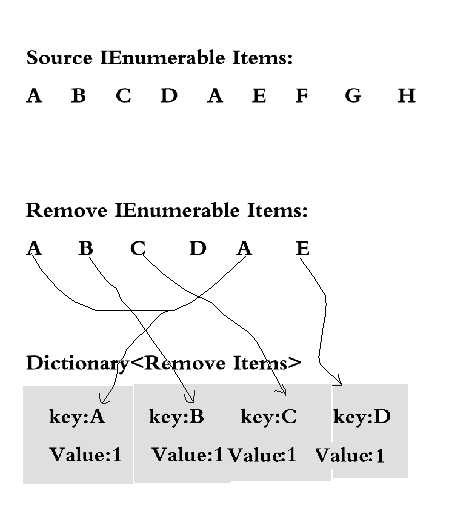
上面是一个示意图,A B C D E 作为Key 其中Value值匀为1。
我们看到,A重复了两次,那么在字典里value 标计匀重置为1,B出现了一次,标计为1,这样做不是多此一举吗?
要知道字典是通过Key寻找键值的,速度远远超过foreach 遍历List强的多。
好了,我们按照上面的思路写出方法:
public static IEnumerable<T> RemoveAll<T>(this IEnumerable<T> source, IEnumerable<T> items) { var removingItemsDictionary = new Dictionary<T, int>(); var _count = source.Count(); T[] _items = new T[_count]; int j = 0; foreach (var item in items) { if (!removingItemsDictionary.ContainsKey(item)) { removingItemsDictionary[item] = 1; } } for (var i = 0; i < _count; i++) { var current = source.ElementAt(i); if (!removingItemsDictionary.ContainsKey(current)) { _items[j++] = current; } } return _items; }
方法很简单吧,其实我们主要想利用字典的Key 快速匹配,至于值就没那么重要了。
字典的索引时间上是O(1),遍历source时间是O(M) 总计时间理论上应该上O(M+N)而不是O(M*N)。
上面的代码,我们为了让调用方便,故去扩展IEnumerable<T>,下面我们来测试下看看时间有没有提高多少?
IEnumerable<string> dd = source.RemoveAll(remove);
这次,哈哈,既然仅仅只用了0.016001...s,上面几个例子用了16s 相差太大了,足足提高了1000倍之多,果然采用字典方式,性能上来了,这样的代码,放在项目才具有实际意义!
其实仔细分析上面代码还是有问题的
T[] _items = new T[_count]; //这里只是粗略的一次性定义了一个_count大小的数组,这样的数据远远超出真真使用的数组
通过上面的分析,产生了很多项NULL的多余项,如果要是能够自动扩展大小,那就更好不过了。
这个时候,想起了链表形式的东西。
为了在进更一步的提高下性能,众所周知,hashcode为标志一个数据的‘指标‘,如果我们能够判断hashcode是否相等,也许可以提高一点性能,如果看到字典的源码,很多人会很快想起,是如何构造了一个类似Set<T>的‘数据组‘。
试想下,如果我们现在有一个‘特殊字典’,特殊在,我们添加相同的key的时候,返回的是false,而只有不重复的项才可以成功的添加进来,这样我们所得的‘数组’就是我们想要的。
可能我说的有点抽像,就像下面这样
public static IEnumerable<TSource> Iterator<TSource>(this IEnumerable<TSource> first, IEnumerable<TSource> second, IEqualityComparer<TSource> comparer) { Set<TSource> iteratorVariable = new Set<TSource>(comparer); foreach (TSource local in second) { iteratorVariable.Add(local); } foreach (TSource iteratorVariable1 in first) { if (!iteratorVariable.Add(iteratorVariable1)) { continue; } yield return iteratorVariable1; } }
其中yield iteratorVariable1 产生的即是我们想要的‘数组’,这里只所以那么强悍,归功于Set<TSource>
我先把所有的代码贴出来,然后一点一点的讲解,不至于片面的头晕
Set<T>构造器:Slots
internal class Set<TElement> { private IEqualityComparer<TElement> comparer; private int count; private int freeList; private Slot<TElement>[] slots; private int[] buckets; public Set() : this(null) { } public Set(IEqualityComparer<TElement> comparer) { if (comparer == null) { comparer = EqualityComparer<TElement>.Default; } this.comparer = comparer; this.slots = new Slot<TElement>[7]; this.buckets = new int[7]; this.freeList = -1; } private bool Find(TElement value, bool add) { int hashCode = this.InternalGetHashCode(value); for (int i = this.buckets[hashCode % this.buckets.Length] - 1; i >= 0; i = this.slots[i].next) { if ((this.slots[i].hashCode == hashCode) && this.comparer.Equals(this.slots[i].value, value)) { return true; } } if (add) { int freeList; if (this.freeList >= 0) { freeList = this.freeList; this.freeList = this.slots[freeList].next; } else { if (this.count == this.slots.Length) { this.Resize(); } freeList = this.count; this.count++; } int index = hashCode % this.buckets.Length; this.slots[freeList].hashCode = hashCode; this.slots[freeList].value = value; this.slots[freeList].next = this.buckets[index] - 1; this.buckets[index] = freeList + 1; } return false; } private void Resize() { int num = (this.count * 2) + 1; int[] numArray = new int[num]; Slot<TElement>[] destinationArray = new Slot<TElement>[num]; Array.Copy(this.slots, 0, destinationArray, 0, this.count); for (int i = 0; i < this.count; i++) { int index = destinationArray[i].hashCode % num; destinationArray[i].next = numArray[index] - 1; numArray[index] = i + 1; } this.buckets = numArray; this.slots = destinationArray; } public bool Add(TElement value) { return !this.Find(value, true); } internal int InternalGetHashCode(TElement value) { if (value != null) { return (this.comparer.GetHashCode(value)); } return 0; } } internal struct Slot<TElement> { internal int hashCode; internal TElement value; internal int next; }
当数组不够时进行扩容(在当前的基础上*2的最小质数(+1)),然后进行重新hashcode碰撞形成链表关系:
private void Resize() { int num = (this.count * 2) + 1; int[] numArray = new int[num]; Slot<TElement>[] destinationArray = new Slot<TElement>[num]; Array.Copy(this.slots, 0, destinationArray, 0, this.count); for (int i = 0; i < this.count; i++) { int index = destinationArray[i].hashCode % num; destinationArray[i].next = numArray[index] - 1; numArray[index] = i + 1; } this.buckets = numArray; this.slots = destinationArray; }
估计看到上面的代码,能晕倒一大片,哈哈~晕倒我不负责哦。
下面我们来分析一些原理,然后再回过头看上面的代码,就很清淅了,必竟写代码是建立在一种思想基础上而来的嘛!
public Set(IEqualityComparer<TElement> comparer) { if (comparer == null) { comparer = EqualityComparer<TElement>.Default; } this.comparer = comparer; this.slots = new Slot<TElement>[7]; this.buckets = new int[7]; this.freeList = -1; }
我们看到,Dictionary在构造的时候做了以下几件事:
首先,我们构造一个:
Set<TSource> iteratorVariable = new Set<TSource>(NULL);
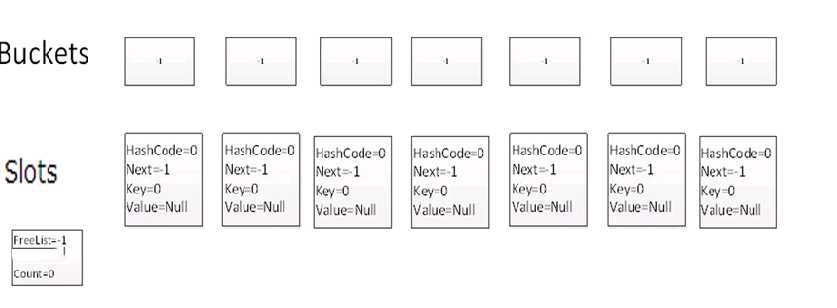
添加项时候的变化
Add(11,”11″)
根据Hash算法 11.GetHashCode()%7=4,因此再次碰撞到Buckets中下标为4的槽上,由于此槽上的值已经不为-1,此时Count=1,因此把这个新加的元素放到slots中下标为1的数组中,并且让Buckets槽指向下标为1的slots中,下标为1的slots之下下标为0的slots。

Add(18,”18″)
我们添加18,让HashCode再次碰撞到Buckets中下标为4的槽上,这个时候新元素添加到count+1的位置,并且Bucket槽指向新元素,新元素的Next指向slots中下标为1的元素。此时你会发现所有hashcode相同的元素都形成了一个链表,如果元素碰撞次数越多,链表越长。所花费的时间也相对较多。
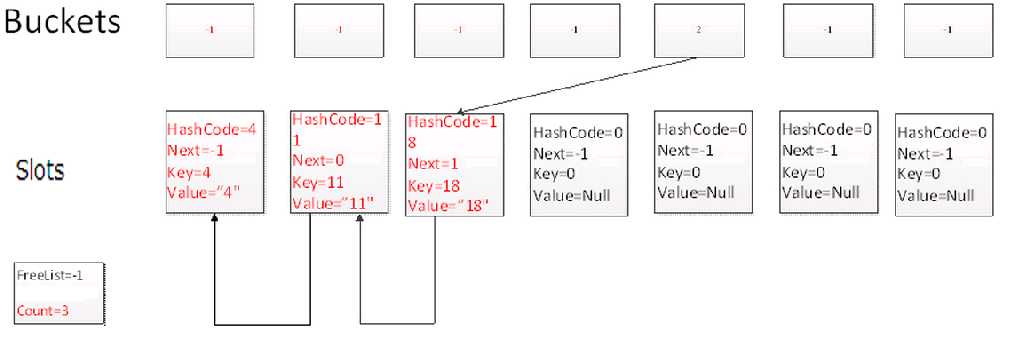
Add(19,”19″)
再次添加元素19,此时Hash碰撞到另外一个槽上,但是元素仍然添加到count+1的位置。
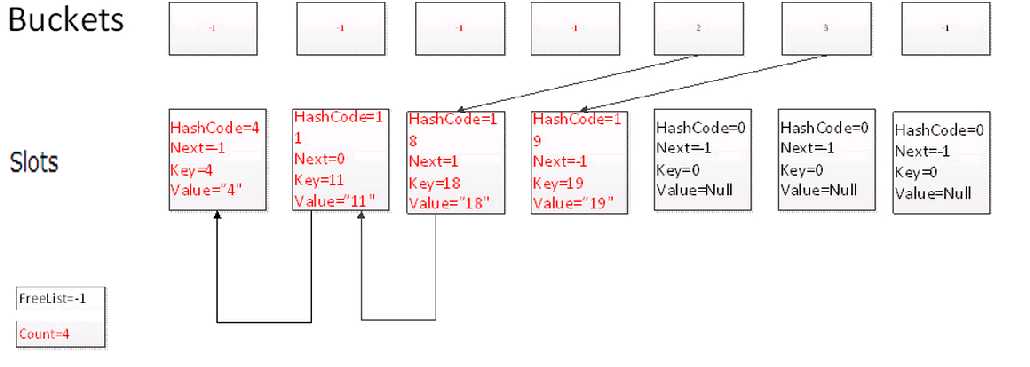
删除项时的变化:
Remove(4)
我们删除元素时,通过一次碰撞,并且沿着链表寻找3次,找到key为4的元素所在的位置,删除当前元素。并且把FreeList的位置指向当前删除元素的位置
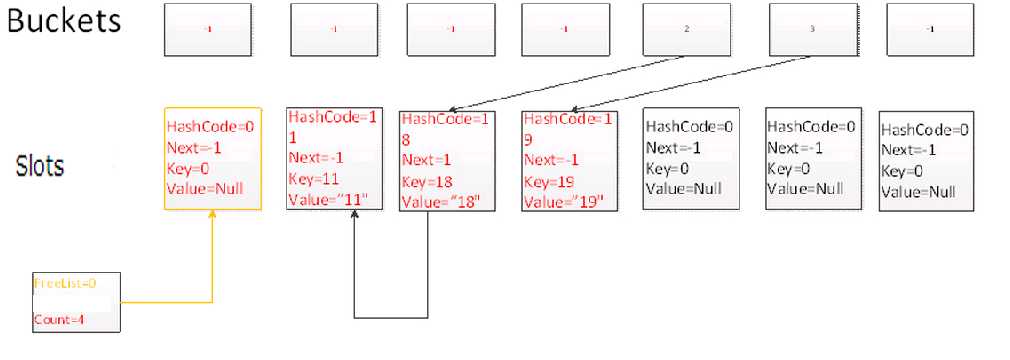
Add(20,”20″)
再添加一个元素,此时由于FreeList链表不为空,因此字典会优先添加到FreeList链表所指向的位置,添加后,FreeList链表长度变为1
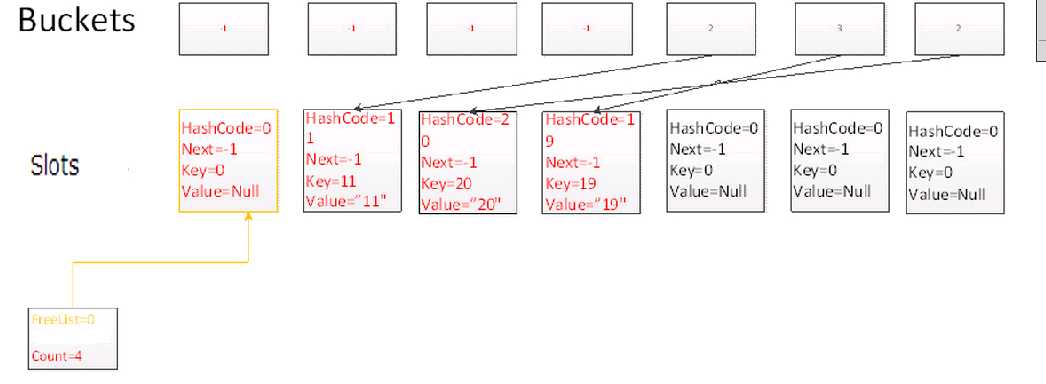
部分图片参考自互联网,哈哈,然后重画,写文章真心不容易,太耗时间,此时四个小时已过去。
通过以上,我们可以发现Set<T>在添加,删除元素按照如下方法进行:
至此,我们再回过头来,看看代码,我想不攻自破!不明白的请多多想想,不要老问!
再次测试下看下结果(这些方法我用扩展方法,没事的朋友可以自已写下,代码在上面已经贴出,这里主要看的比较直观些)
DateTime now = DateTime.Now; Set<string> iteratorVariable = new Set<string>(null); foreach (var local in remove) { iteratorVariable.Add(local); } foreach (var local in source) { if (!iteratorVariable.Add(local)) { continue; } } Console.WriteLine("Running time:" + (DateTime.Now - now).TotalSeconds); Console.ReadKey();
所消耗时间Running time:0.0112076..s
看到没,与上面的例子性能上相差不大。但是也远远超过了前面三个例子。而且也是自动扩容的,引入了hashcode碰撞,这是一种思想,很多.net字典也是基于这种原理实现的。没事的同学可以看看.net 相关源码。
最近我想说的一件事,在个方法其它等同于Except<IEnumerable<T>>(),在Linq .net 3.5+微软已经给我们实现。
请不要骂我,刚开始我也不知道这个方法,写着写着想起来了。微软的进步,正悄悄的把我们省了很多事。然后,依据微软的方法进行改进而来。
到这里,不知不觉的你已经学会了一种‘算法’。即使微软提供了我们现成的方法,也不足为奇!必竟思想的提练是我们最终的目标!
为IEnumerable<T>添加RemoveAll<IEnumerable<T>>扩展方法--高性能篇
标签:
原文地址:http://www.cnblogs.com/laogu2/p/5953952.html